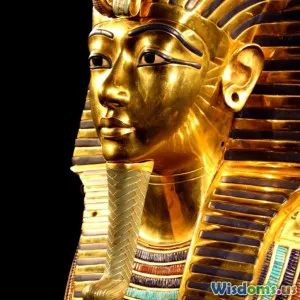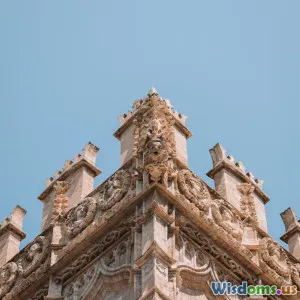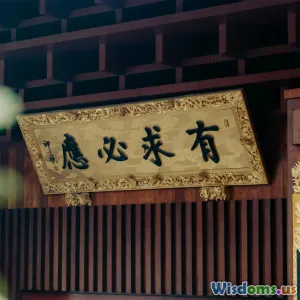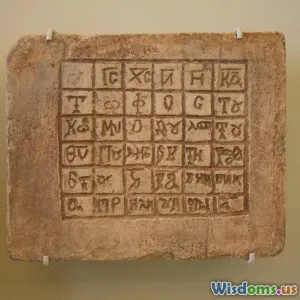
Ten Commodities That Built Ancient Egyptian Wealth
9 min read Explore the ten key commodities that powered Egypt's ancient economy, fueling its wealth and global influence. (0 Reviews)
Ten Commodities That Built Ancient Egyptian Wealth
Ancient Egypt, the cradle of one of the world’s earliest civilizations, dazzled not only with its monumental pyramids and enduring hieroglyphs but also through its remarkable economic prowess. What fueled this wealth and power? While many associate Egyptian riches primarily with gold and pharaohs, the reality is a complex web of essential commodities that underpinned its flourishing economy. This article takes you on a deep dive into ten key commodities instrumental in building and sustaining Ancient Egyptian wealth, shedding light on their significance, uses, and lasting impact.
1. Grain: The Staple of Egypt’s Surplus
Grain, especially emmer wheat and barley, was the lifeblood of Egypt’s economy. Thanks to the predictability of the Nile River’s annual flood, Egypt boasted incredibly fertile lands bordering the riverbanks, allowing it to harvest bumper crops consistently. This agricultural success resulted in food surplus, supporting population growth and the establishment of cities.
Beyond sustenance, grain became a form of currency and tribute, stored in granaries to pay workers, support the military, and fund monumental architecture. Historian Toby Wilkinson notes that "grain underpinned not only the daily diet but also the economic essence of Egyptian statecraft and taxation."
Example: The granaries of ancient Thebes stored vast amounts, enabling Pharaoh Ramses III to conduct building projects and sustain armies.
2. Papyrus: Egypt’s Iconic Writing Material
Papyrus, a reed native to the Nile Delta, was integral for communication and administration. The Egyptians converted it into paper-like sheets facilitating record-keeping, literature, and religious texts.
Its export also contributed to Egypt’s wealth; papyrus was highly prized across the Mediterranean. The making of papyrus sheets required skilled labor, creating a specialized trade demonstrating an early form of intellectual property.
The Greek historian Herodotus praised Egyptian papyrus as superior, calling it “the finest writing materials in the known world.”
3. Gold: The Symbol and Substance of Wealth
Gold mining and craftsmanship made Egypt synonymous with opulence. The Eastern Desert and Nubia were rich sources of gold, exploited since the Old Kingdom period.
Gold’s cultural and religious symbolism was profound: it was associated with immortality and the divine, used extensively in tomb coverings, jewelry, and temple décor, most famously in King Tutankhamun’s death mask.
Economically, Egypt’s gold supported trade diplomacy with neighboring civilizations, allowing it to become a central trading hub in the ancient world.
Fact: Nubian gold mines were under Egyptian control, allowing Pharaohs to amass vast quantities fueling international power.
4. Linen: The Fabric of Society
Linen, woven from flax cultivated mainly in the Nile Delta, was Egypt’s chief textile. Its lightness and breathability suited the hot climate and became a symbol of purity, often used in mummification wrappings and ceremonial garments.
The linen industry also bolstered Egypt’s economy through exports. Egyptian linen was famed for its high quality across the ancient Mediterranean, valued by Greeks and Romans alike.
5. Stone: The Foundation of Monumental Architecture
Quarries yielded limestone, sandstone, granite, and basalt—materials foundational to Egypt’s iconic temples, pyramids, and statues. These stones were not only construction resources but also economic commodities due to labor and craftsmanship involved.
For example, most pyramids utilized locally quarried limestone, but the granite for the King's Chamber in the Great Pyramid was sourced from Aswan, demonstrating trade and transportation logistics across nations.
Remarkably, the state-controlled quarrying industry employed thousands, stimulating economic activity linked to architecture and religious practice.
6. Copper and Bronze: Tools of Progress
Metallurgy advances empowered Egypt’s economy and warfare. Copper extracted from Sinai mines was refined and alloyed with tin to create bronze — a harder, more durable metal pivotal for tools, weapons, and jewelry.
The rise of bronze tools improved agricultural productivity, facilitated construction, and aided the manufacturing of trade goods, reinforcing Egypt’s status as a developed civilization.
7. Incense and Perfumes: Aromatic Luxuries
Certain commodities like frankincense and myrrh, though imported from Arabia and Africa, became highly coveted in Egypt for religious rituals and daily life. Egyptians used these aromatic resins in temples, funerary practices, and personal grooming.
These imports were so valuable they became a form of currency and status symbol, with evidence that Egyptians controlled caravan routes contributing to the incense trade.
Real-world insight: Egyptian texts describe perfume-making as a royal secret, accentuating the luxury trade’s importance.
8. Wheat and Beer: Daily Staples Brewing Prosperity
While related to grain in general, wheat specifically supported both food and beverage industries. Beer, brewed from barley or wheat, was central to Egyptian diet and culture. It was considered a nutritional staple and used as payment for workers.
Archaeological finds at Abydos highlight beer vats capable of producing thousands of liters, indicating large-scale brewing as an economic driver.
9. Precious Stones and Faience: Beauty and Status
Egyptians crafted jewelry from lapis lazuli, turquoise, carnelian, and faience — a glazed ceramic material. While the stones were often imported, the elaborate use of such materials communicated social hierarchy and wealth.
These products became major trade items, showcasing Egypt’s artisanship which influenced neighboring cultures. Faience production techniques were so advanced they persisted beyond Egypt’s prominence.
10. Livestock: Assets of Trade and Agriculture
Animals like cattle, sheep, goats, and donkeys were crucial economic assets. Livestock boosted agriculture through plowing and transportation, while also providing meat, leather, and wool for domestics and markets.
Egypt’s pastoral economy allowed for trading of animals and animal products, supporting wealth distribution and societal sustenance.
Historical records show Pharaohs bestowed cattle as royal gifts, indicating their value beyond agriculture — representing social and political currency.
Conclusion
The grandeur of Ancient Egypt rests on more than monumental architecture or iconic pharaohs — it is built upon a carefully cultivated economy driven by diverse, vital commodities. From food staples sustaining populations to luxury goods signaling power and status, each commodity illuminated Egypt’s multifaceted wealth. Grains and linen exemplify practical economies, while gold, precious stones, and incense highlight Egypt’s diplomatic and cultural reach.
Through understanding these ten commodities, one gains deeper appreciation not only of Egypt’s history but also of the complexity early civilizations managed to thrive. Their legacy continues, reminding us how natural resources, trade, and culture intertwine to create enduring wealth.
References:
- Wilkinson, Toby. The Rise and Fall of Ancient Egypt. Random House, 2010.
- Clayton, Peter. Chronicle of the Pharaohs. Thames & Hudson, 2006.
- Herodotus, Histories, translated by Aubrey de Sélincourt.
- Bard, Kathryn A. An Introduction to the Archaeology of Ancient Egypt. Wiley-Blackwell, 2015.
Explore further: The economic infrastructure of Ancient Egypt informs modern studies in sustainable resource management and trade networks, inspiring today’s scholars and entrepreneurs alike.
Rate the Post
User Reviews
Popular Posts




















